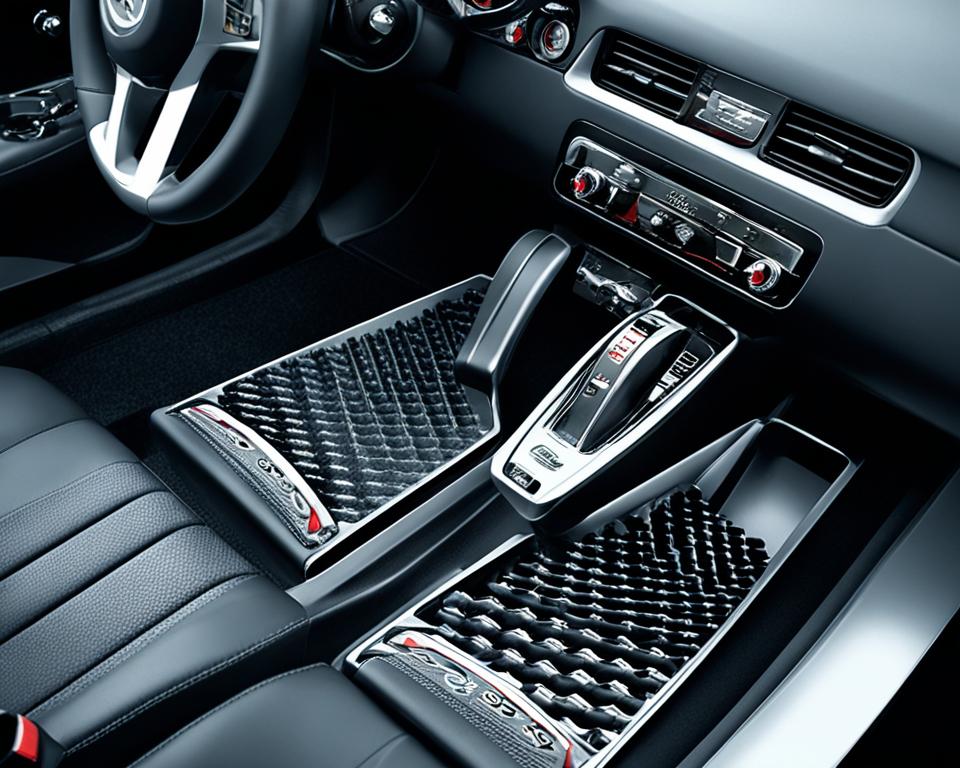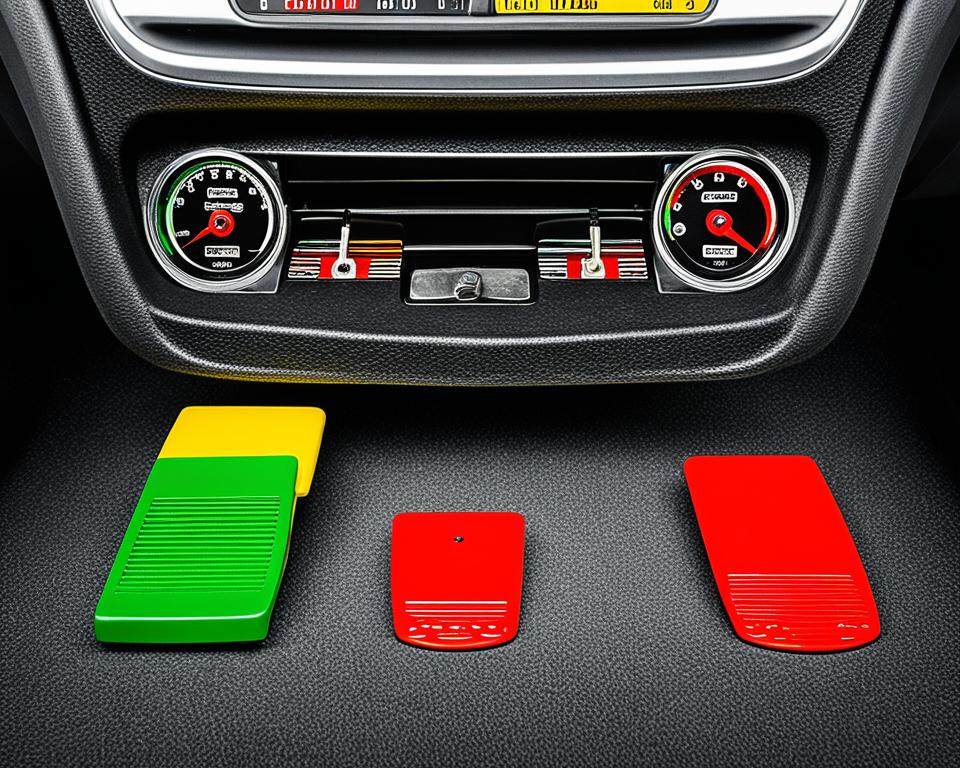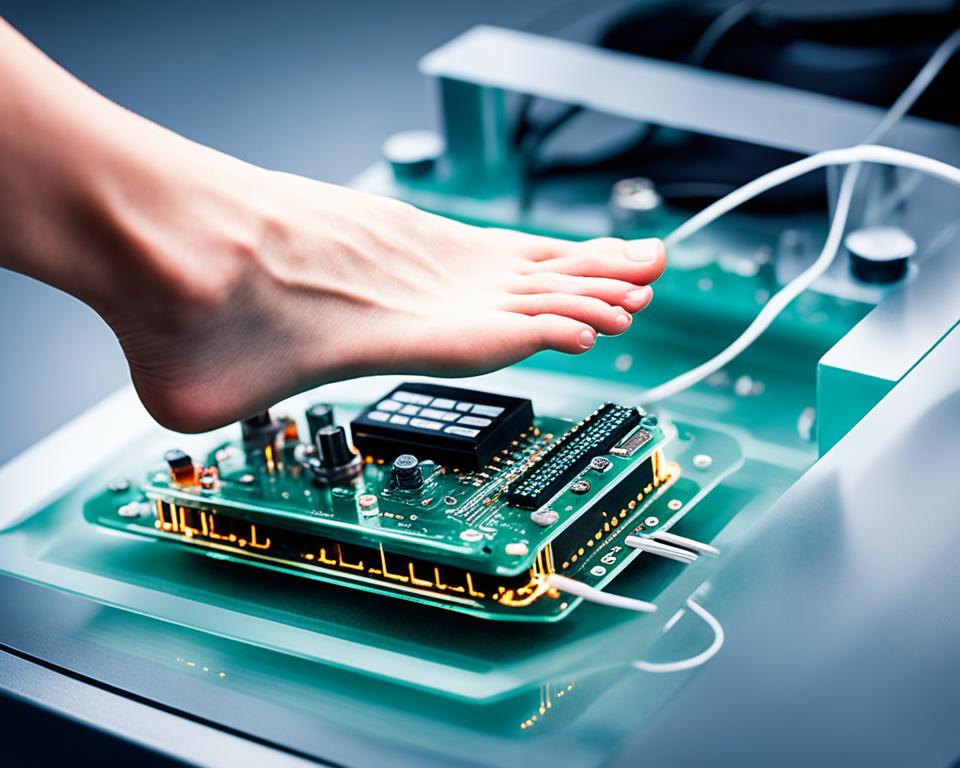
The car is a key part of our daily lives. At its core is a vital piece that lets us control it – the auto car pedals. These pedals are crucial for safe and smooth driving. They help us speed up, slow down, and shift gears in manual cars.
This article will cover the world of auto car pedals. We’ll look at their types, roles, and why keeping them in good shape is important. It’s for both new and experienced drivers. You’ll learn how these pedals make driving better.
Read interesting things at : web-quanto
Key Takeaways
- Auto car pedals are essential components that enable drivers to control the movement and operation of a vehicle.
- The main types of car pedals include the accelerator pedal, brake pedal, and clutch pedal (in manual transmission vehicles).
- Proper maintenance and adjustment of car pedals are crucial for safe and efficient driving.
- Advancements in technology, such as drive-by-wire systems, are transforming the way car pedals function and interact with the vehicle’s systems.
- Selecting the right pedals, whether OEM or aftermarket, is important for driver comfort and control.
Introduction to Auto Car Pedals
Driving a car is complex and requires precise control. At the core of this control are the auto car pedals. These pedals, including the accelerator, brake, and clutch for manual transmissions, connect the driver to the car.
Importance of Pedals in Driving
The car pedal system is key to safe and efficient driving. It helps control speed, braking, and gear changes in manual transmissions. This lets drivers handle different driving conditions smoothly.
Using the driving controls right is crucial. It keeps control, adapts to road changes, and keeps everyone safe.
Types of Car Pedals
- Accelerator Pedal: Also known as the gas or throttle pedal, this controls the engine’s power delivery and, consequently, the vehicle’s speed.
- Brake Pedal: This pedal activates the braking system, allowing the driver to slow down or stop the vehicle as needed.
- Clutch Pedal: Found in vehicles with manual transmissions, the clutch pedal engages and disengages the connection between the engine and the drivetrain, enabling gear changes.
These vehicle pedals work together to give the driver control over the car’s foot controls. This makes driving safe and fun.
The Accelerator Pedal
The accelerator pedal, also known as the gas pedal, is key to a vehicle’s controls. It helps control the car’s speed and power. By pressing the pedal, drivers can adjust the engine’s throttle. This lets them speed up and keep a steady pace easily.
Function and Operation
The accelerator pedal links to the engine’s throttle, usually by a cable or sensors. When pressed, it tells the engine to take in more fuel and air. This means more power and faster speeds. How hard the pedal is pressed controls how much power the engine gives out.
Maintenance and Repairs
Keeping the accelerator pedal in good shape is vital for safe driving. Regular checks can spot problems with the pedal’s parts. If there are issues, it’s important to get help from car experts to fix them quickly.
| Key Aspects of the Accelerator Pedal | Description |
|---|---|
| Function | Controls the vehicle’s speed and power output by regulating the engine’s throttle |
| Operation | Connected to the engine’s throttle system, either through a cable or electronic sensors |
| Maintenance | Regular inspections and timely repairs to ensure optimal performance and safety |
“The accelerator pedal is the driver’s direct link to the engine, allowing them to harness the full power of the vehicle with precision and control.”
The Brake Pedal
The automobile brake pedal is key to safe driving. It helps slow down and stop the vehicle. This makes it crucial for everyone’s safety inside.
The brake pedal works with the car’s brakes. When you press it, it sends hydraulic pressure to the brake pads or discs. This pressure makes the brake pads squeeze the wheels, slowing the car down.
- The brake pedal is a vital part of the car pedal system and driving controls. It lets the driver control speed and react to the road.
- Keeping the brake pedal in good shape is key for safe braking. It helps avoid safety problems.
“The brake pedal is the primary means by which the driver can control the speed and direction of the vehicle, making it a critical component for safe driving.”
Knowing how the brake pedal works is important for drivers and car lovers. It helps them understand the car’s controls better. This way, they can take better care of this important part of the car.
The Clutch Pedal
In cars with a manual transmission, the clutch pedal is key to the driving controls and car pedal setup. It helps disengage and engage the clutch. This lets the driver change gears smoothly and speed up the car.
Role in Manual Transmissions
The clutch pedal is vital in a manual transmission car. When pressed, it breaks the link between the engine and the transmission. This lets the driver shift gears without stopping the car’s power flow. It makes shifting gears smooth and gives the driver full control over the car’s driving controls.
- The clutch pedal disconnects the engine from the transmission, allowing the driver to change gears without grinding or stalling the engine.
- Pressing the clutch pedal fully disengages the clutch, enabling the driver to shift the manual transmission into the desired gear.
- Releasing the clutch pedal gradually re-engages the clutch, transferring power from the engine to the transmission and allowing the vehicle to accelerate smoothly.
Using the clutch pedal right is key for the car’s pedal system to last long. It also makes driving a manual transmission car comfortable and smooth.
Pedal Assembly and Design
The pedal assembly is key to a car’s control system. It lets drivers control the car’s speed, brakes, and clutch smoothly. This setup includes many materials and parts that work together perfectly.
Materials and Construction
The car pedal system uses strong materials like metal alloys, high-strength plastics, and reinforced composites. These materials can handle the constant pressure and stress of driving. This makes the pedal assembly reliable and quick to respond over time.
The vehicle pedals are made from light yet strong metals like aluminum or steel. This gives them the needed strength and control. The pedal linkages, which connect the pedals to the car’s systems, are made to send the driver’s actions precisely and efficiently.
The foot controls are designed for comfort and fit well with the driver’s movements. This makes using the automobile brake pedal and other pedals safe and easy. The pedal assembly fits well into the car’s dashboard and control layout, making it easy to reach and use.
Advances in materials science and engineering are making the pedal assembly better. They focus on making it more durable, responsive, and comfortable for drivers. As cars get more advanced, the car pedal system stays a key part of driving. It connects the driver to the car’s main functions and shapes the driving experience.
auto car pedals
The auto car pedals are key for drivers to control their vehicles. They are vital for managing speed, braking, and sometimes the clutch. The accelerator pedal controls engine power, while the brake pedal slows the car down.
The auto car pedals connect the driver with the car’s systems. They let drivers control the car smoothly and efficiently. These vehicle pedals are made to be strong, reliable, and quick. This ensures drivers have full control over their driving controls.
When driving, the car pedal system links your feet to the car’s performance. Knowing how to use and maintain these foot controls is key for safe driving. So, the auto car pedals are a key part of any car’s design and how it works.

“The pedals are the pilot’s hands on the ground.” – Mario Andretti, Formula One Champion
Ergonomics and Pedal Positioning
The way a car’s pedals are set up is key to making driving comfy and in control. The design and position of the driving controls, car pedal system, and vehicle pedals affect how easy it is to use the foot controls. This also shapes the overall ergonomics of driving.
Optimizing Driver Comfort
Getting the pedals in the right spot is vital for a comfy driving position. The accelerator, brake, and clutch pedals should fit the driver’s height, leg length, and foot size. This makes it easy to use the foot controls without straining or feeling awkward.
Things like how far apart the pedals are, their height, and angle matter for comfort. Making these right can cut down on tiredness, improve control, and make driving better overall.
| Pedal Ergonomic Factor | Optimal Range |
|---|---|
| Pedal Spacing | 3-5 inches between pedals |
| Pedal Height | 2-6 inches from floor |
| Pedal Angle | 10-20 degrees from vertical |
By making the vehicle pedals more ergonomic, car makers and accessory companies can make driving more comfy and fun for many drivers.
Pedal Adjustments and Customization
The car pedal system is key to how we drive. It includes the accelerator, brake, and clutch pedals. These foot controls greatly affect how a car handles and responds. Many drivers don’t know they can customize their car’s pedals.
Customizing the pedals lets drivers make the driving experience better fit their needs and body type. By adjusting the pedals’ position, resistance, and movement, drivers can feel more comfortable and in control. This reduces tiredness and improves driving skills.
Adjustable Pedal Systems
Now, many cars have pedals that can be moved to fit the driver better. This is great for drivers of different heights or those with physical issues. You can move the pedals closer or farther, making sure they’re just right for you.
Aftermarket Pedal Customization
For more personal touches, there are many options available. You can find adjustable kits and special pedals to change how your car’s pedals work. You can change the size, shape, and even the material of the pedals for a better feel.
| Customization Option | Benefits |
|---|---|
| Adjustable Pedal Positioning | Improved driver comfort and control |
| Pedal Size and Shape Modification | Enhanced foot placement and feedback |
| Pedal Material Upgrades | Increased durability and responsiveness |
The car pedal system is getting more important as cars evolve. By using pedal adjustments and customization, drivers can make driving better fit their needs. This leads to a more enjoyable and personal driving experience.
Electronic Pedal Systems
The car pedal system has seen big changes as the automotive industry grows. Electronic pedal systems, or drive-by-wire technology, are a big part of this change.
Drive-by-Wire Technology
Drive-by-wire technology changes how cars work. It moves away from old mechanical links between pedals and controls. Now, pedals talk to the car’s computer through sensors and actuators.
This new way brings many benefits. It gives drivers better control, makes the car respond faster, and is more reliable. It also lets cars work better, use less fuel, and be safer. That’s why it’s becoming a top choice for new car pedal systems.

Electronic pedal systems and drive-by-wire technology are key to making cars drive themselves or help drivers drive better. They make the car’s controls work together better, making driving smoother.
“The future of automotive driving controls lies in the seamless integration of advanced vehicle pedals and intelligent computer systems.”
As cars keep getting smarter, we’ll see more drive-by-wire technology and electronic pedal systems. This will change how we use our cars and shape the future of driving.
Pedal Maintenance and Troubleshooting
Keeping the car pedal system in good shape is key for safe driving. Each pedal, from the accelerator to the brake and clutch, is crucial for controlling the car. Taking care of these parts and fixing issues quickly can make your car safer and run better.
Troubleshooting Common Pedal Problems
Checking your pedals often and fixing any problems fast can prevent safety risks. Watch out for these pedal issues:
- Sticking or unresponsive pedals
- Excessive play or looseness in the pedal mechanism
- Unusual noises or vibrations when pressing the pedals
- Pedal feel that is too soft or too firm
- Leaks in the hydraulic system (for brake and clutch pedals)
If you notice any of these problems, get your car’s car pedal system checked by a pro right away. They can find and fix the cause.
Pedal Maintenance Tips
Here are some tips to keep your vehicle pedals working well:
- Check how the pedals move and adjust them if needed to ensure they work smoothly.
- Look for wear or damage on pedal linkages, bushings, and pivot points. Replace them if necessary.
- Keep an eye on hydraulic fluid levels and fix leaks quickly to avoid more problems.
- Clean and lubricate the pedal parts now and then to keep them running smoothly.
- Follow the maker’s advice for updates and checks on electronic driving controls.
Being proactive with pedal maintenance and fixing issues fast helps your car’s pedal system work well. This makes driving safer.
| Common Pedal Issues | Potential Causes | Recommended Actions |
|---|---|---|
| Sticking or unresponsive pedals | Worn linkages, binding pivot points, or issues with electronic sensors | Inspect and replace faulty components, ensure proper adjustments |
| Excessive pedal play or looseness | Worn bushings, loose mounting, or issues with pedal pivot | Replace worn parts, tighten mounting hardware, adjust pedal travel |
| Unusual noises or vibrations | Worn bearings, loose connections, or issues with the pedal mechanism | Diagnose the source of the noise, replace affected components |
| Pedal feel issues (too soft or too firm) | Problems with the hydraulic system (for brake and clutch) or electronic sensor calibration | Check fluid levels, bleed the system, or recalibrate electronic sensors |
| Hydraulic system leaks | Worn seals, damaged lines, or issues with the master cylinder | Identify and repair the source of the leak, replace affected components |
Pedal Safety Considerations
Driving safely is more than just handling the car’s controls. The pedals are key to keeping drivers safe. It’s vital to know how to use them right and avoid mistakes.
Preventing Pedal Misapplication
Pressing the wrong pedal by mistake can be dangerous. This mistake often happens when drivers are distracted, confused, or new to driving. It can cause sudden speeding, braking, or losing control of the car. To avoid this, drivers should know where the pedals are and use them correctly.
- Get to know the pedal setup in your car so you can tell the accelerator, brake, and clutch apart.
- Use the pedals with focus and keep your eyes on the road.
- Don’t do other things while driving to lower the chance of pressing the wrong pedal.
- Be careful when driving a new car or adjusting to a different pedal setup.
Putting pedal safety first and taking steps to prevent mistakes can greatly lower the risk of accidents. This helps drivers stay in control and makes driving safer for everyone.
| Pedal Safety Considerations | Description |
|---|---|
| Pedal Arrangement Awareness | Know the pedal layout in your car to avoid mistakes. |
| Focused Pedal Usage | Have a regular way of using the pedals and keep your eyes on the road. |
| Distraction Avoidance | Avoid doing other things while driving to keep your focus on the road. |
| Vigilance in Unfamiliar Vehicles | Be more careful when driving a car with pedals you’re not used to. |
By focusing on pedal safety and being proactive, drivers can cut down on accidents and keep better control of their cars. This makes driving safer for everyone.
Pedal Innovations and Future Trends
The car pedal system is always changing, with new technologies and designs making driving better. We can expect many exciting changes in the future.
One big trend is using advanced sensors in vehicle pedals. These sensors give real-time feedback on how hard you press the pedal and how it responds. This makes driving more precise and lets cars work better with other systems.
Also, pedals might get lighter, stronger, and more comfortable in the future. They could be made of materials that are both strong and light. This would make driving safer and more comfortable for everyone.
Another trend is making pedals work better with car features like entertainment systems and safety tools. This could mean controlling your car with voice or gestures, making driving easier and more fun.
Looking ahead, the car pedal system will keep getting better thanks to new technology and materials. These changes will change how we use our cars and make driving safer and more fun.
| Pedal Innovation | Description | Potential Impact |
|---|---|---|
| Advanced Sensor Integration | Incorporation of sensors to provide real-time feedback on pedal position, pressure, and responsiveness. | Enables more precise control, customized driving dynamics, and development of autonomous driving features. |
| Lightweight and Ergonomic Designs | Advancements in materials and construction to create pedals that are comfortable, responsive, and safe. | Improves driver comfort and overall driving experience. |
| Seamless Integration with In-Vehicle Technologies | Pedal systems that can interact with infotainment systems and driver assistance features. | Enhances the overall driving experience through intuitive, voice-controlled, or gesture-based interactions. |
The future of the car pedal system is exciting, thanks to ongoing innovation in the car industry. As pedals get better with new technology, drivers will enjoy a smoother, more comfortable ride.
Choosing the Right Pedals for Your Vehicle
Choosing the right pedal system for your car is key to a great driving experience. You have to decide between OEM (original equipment manufacturer) pedals and aftermarket pedals. Each type has its own benefits and drawbacks.
OEM vs. Aftermarket Pedals
OEM pedals come from the car’s manufacturer and are made to work perfectly with your vehicle. They are the safest and most reliable choice. Aftermarket pedals are made by other companies. They offer more customization options, like different materials and designs.
| Factors | OEM Pedals | Aftermarket Pedals |
|---|---|---|
| Fit and Integration | Seamless integration with vehicle | May require modifications for proper fit |
| Reliability | Tested and approved by the manufacturer | Varying levels of quality and durability |
| Customization | Limited options | Wider range of styles, materials, and designs |
| Cost | Generally more expensive | Typically more affordable |
When choosing between OEM and aftermarket pedals, think about what you need and want. Consider the pros and cons of each to find the best fit for your car.
Pedal Replacement and Installation
Keeping your car’s pedal system in top shape is key for safe driving. Upgrading or replacing pedals needs careful steps. This guide will help you smoothly switch to new car pedal system, vehicle pedals, and driving controls.
Preparing for Pedal Replacement
First, check your car pedal system for any problems or wear. This helps you decide if you need a full replacement or just repairs. Make sure to find the right pedal replacement parts for your car’s model and year.
Removing the Old Pedals
- Disconnect the pedal linkage or wiring, taking note of the connections for proper reassembly.
- Unscrew or unbolt the pedal assembly from the vehicle’s floor or firewall.
- Carefully remove the old pedals, ensuring you don’t damage any surrounding components.
Installing the New Pedals
Now, it’s time to put in the new vehicle pedals. Here’s how to do it right:
- Align the new pedal assembly with the mounting points and secure it in place using the appropriate hardware.
- Reconnect the pedal linkage or wiring, ensuring all connections are secure and properly routed.
- Adjust the pedal position and tension as needed to ensure optimal driving controls and driver comfort.
- Test the new pedals thoroughly, checking for smooth operation and proper functionality.
By following these steps, you can replace and install new car pedal system parts with confidence. This ensures your pedals work well and makes driving safe and fun.
Conclusion
This article has shown how important auto car pedals are for controlling and driving a vehicle. The accelerator, brake, and clutch pedals all play key roles in making driving safe and efficient. By knowing how to take care of these pedals and understanding new technologies, drivers can make their driving better and safer.
The pedals connect the driver to the car, allowing for precise control. Keeping these pedals in good shape and using new tech can make driving more comfortable and safe. As cars keep getting better, pedals will become even more important in driving.
It doesn’t matter if you’re driving an old sports car or a new electric one. Knowing about auto car pedals is crucial for every driver. By keeping up with pedal maintenance and new tech, you can improve your driving, make your car run better, and keep everyone safe on the road.






